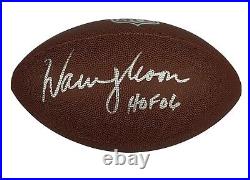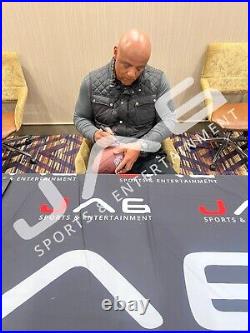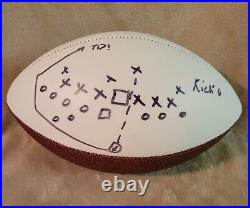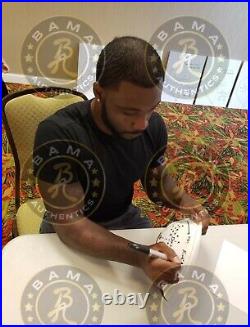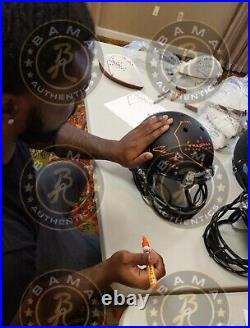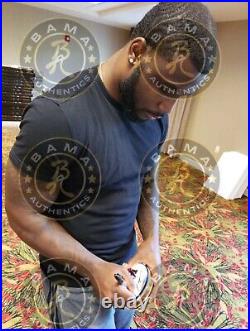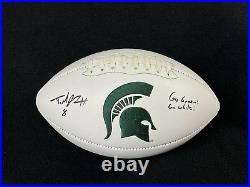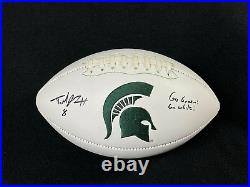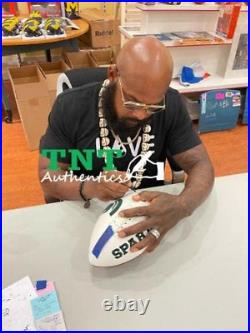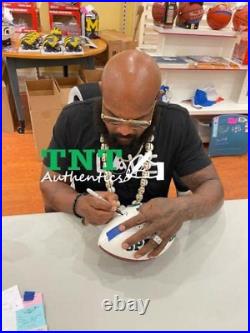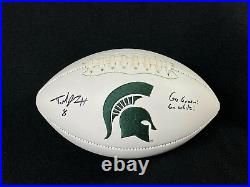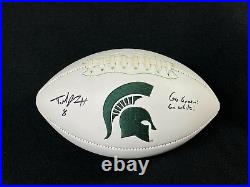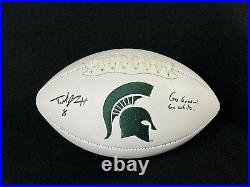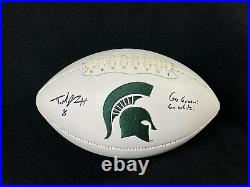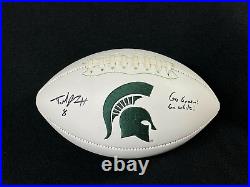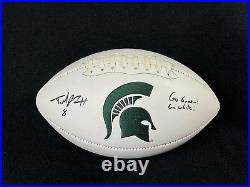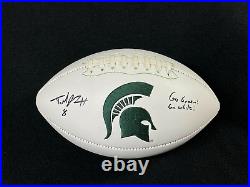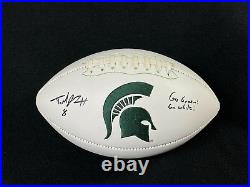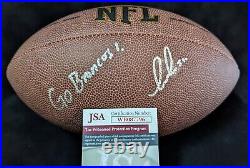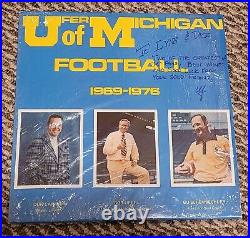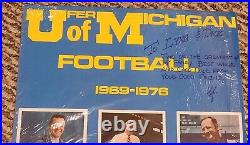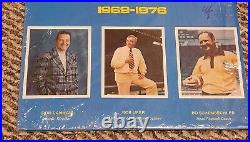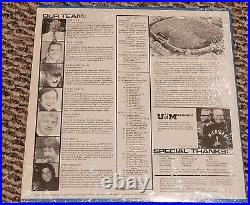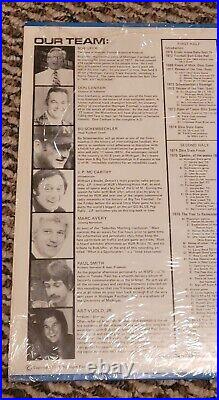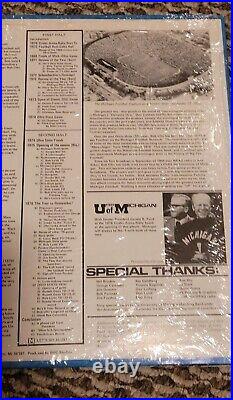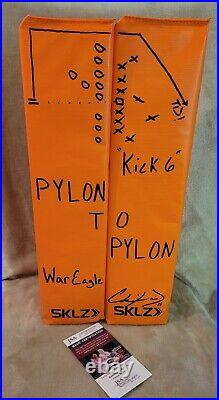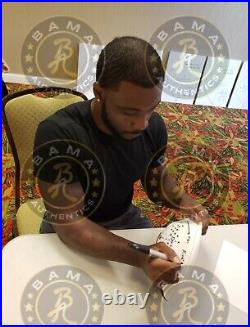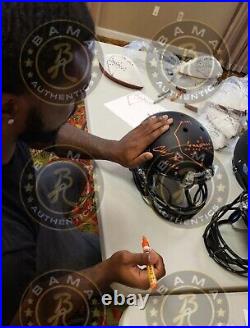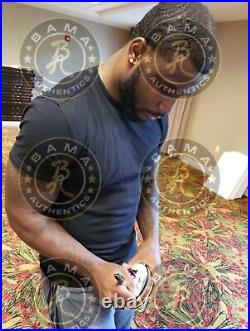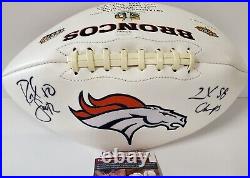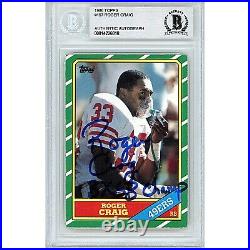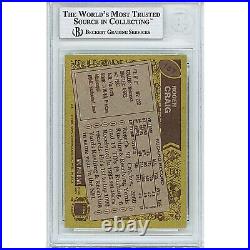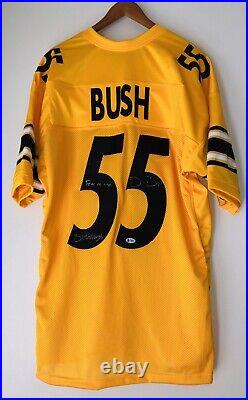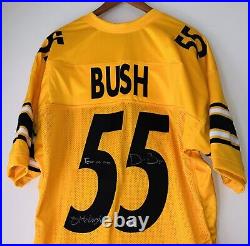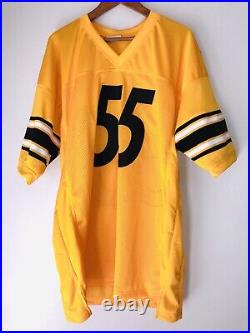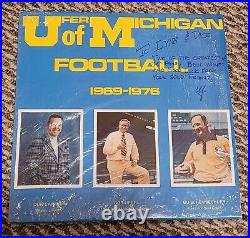
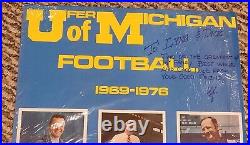
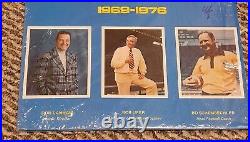
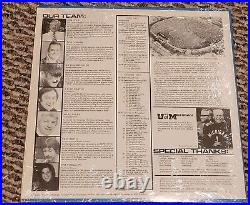
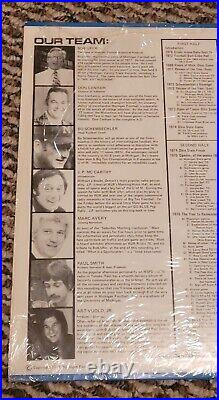
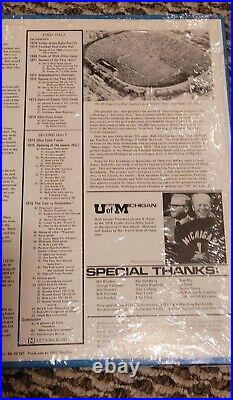

A great hand inscribed University of Michigan Wolverines record signed by Bob Ufer for a fan. The 1933 college football season saw the Michigan Wolverines repeat as winners of the Knute Rockne Memorial Trophy as national champion under the Dickinson System. The unofficial east-west championship game, the Rose Bowl, was between Stanford (8-1-1) who was ranked behind USC and unranked Columbia (7-1). The Columbia Lions won the Rose Bowl game 7-0. Conference and program changes. Two new conferences began play in 1933. Chesapeake Conference – active through the 1936 season. Southeastern Conference (SEC) – active NCAA Division I FBS conference; formed after its thirteen members broke away from the Southern Conference in 1932. Georgia Tech Yellow Jackets. September 23 USC opened its season with a doubleheader against Occidental College, and Whittier College. Using a combination of varsity and reserves, the Trojans won 39-0 and 51-0, respectively. [1] Although future President Richard M. Nixon had been on the freshman football team at Whittier, he was not part of the varsity squad that played against USC. Oregon defeated Linfield College 53-0. Stanford beat San Jose State 27-0. September 30 Stanford narrowly defeated UCLA 3-0, USC beat Loyola Marymount 18-0, and Oregon won at Gonzaga 14-0. Army opened with a 19-6 win over Mercer College. Minnesota beat visiting South Dakota State 19-6. Pittsburgh beat Washington & Jefferson 9-0. October 7 USC defeated Washington State 33-0, Stanford beat Santa Clara 7-0, and Oregon got past Portland College 14-7. Minnesota and Indiana tied 6-6. Michigan (whose team included Gerald Ford as a center) beat Michigan State 20-6, Purdue beat Ohio University 13-6, and Ohio State rolled over Virginia 75-0. Army beat Virginia Military Institute (VMI) 32-0 Pittsburgh beat West Virginia 21-0. Nebraska beat visiting Texas 26-0. Princeton opened its season with a shutout (40-0) over Amherst. October 14 In Minneapolis, Minnesota and Purdue played to a 7-7 tie. In Chicago, Stanford and Northwestern played to a 0-0 tie. Oregon won at Washington 6-0, and USC beat St. Army defeated Delaware 52-0 and Pittsburgh beat Navy 34-6. Ohio State defeated Vanderbilt 20-0. Michigan beat Cornell 40-0. Nebraska won at Iowa State 20-0. Princeton recorded its second shutout, a 45-0 win over Williams. Tennessee suffered its first defeat since 1930, losing 10-2 against Duke. October 21 Michigan beat visiting Ohio State 13-0. Minnesota (1-0-2) hosted Pittsburgh (3-0-0), with the home team Gophers winning, 7-3. Purdue won at Chicago 14-0. In Portland, USC and Oregon State played to a 0-0 tie. Stanford won at the University of San Francisco, 20-13. In Cleveland Army beat Illinois 6-0. Nebraska won at Kansas State 9-0. Oregon beat Idaho 19-0 in a Friday Night game. Princeton beat Columbia, 20-0, to stay unscored upon. October 28 USC narrowly won at California, 6-3, Oregon won at UCLA 7-0, and Stanford lost at Washington 6-0. Michigan won at Chicago 28-0, Ohio State beat Northwestern 12-0, Minnesota beat Iowa 19-7, and Purdue won at Wisconsin 14-0. Army won at Yale 21-0. Pittsburgh won at Notre Dame 14-0. Nebraska beat Oklahoma 16-7. Princeton narrowly won, but stayed unscored upon, with a 6-0 win over Washington & Lee. State, going to the Rose Bowl, and posting a 10-2 record every year. [16][18] After the 1978 season, Woody Hayes was fired for punching an opposing player during the 1978 Gator Bowl, thus ending The Ten Year War. [53] Michigan had a slight edge in the war, with Schembechler going 5-4-1 against Hayes. However, while Schembechler successfully placed great emphasis on the rivalry, Michigan’s bowl performances were sub-par. Michigan failed to win their last game of the season every year during The Ten Year War. [16] The only year in which Michigan didn’t lose its last game of the season was the 1973 tie against Ohio State. After the end of the Ten Year War, Michigan’s regular season performance declined, but its post season performance improved. The 1979 season included a memorable game against Indiana that ended with a touchdown pass from John Wangler to Anthony Carter with six seconds left in the game. [54] Michigan went 8-4 on the season, losing to North Carolina in the 1979 Gator Bowl. In 1980, Michigan went 10-2 and got their first win in the Rose Bowl under Schembechler, a 23-6 win over Washington. [16][18] Michigan went 9-3 in 1981 to get Schembechler’s second bowl win in the 1981 Bluebonnet Bowl. [16][18] In 1982, Michigan won the Big Ten championship while being led by three-time All-American wide receiver Anthony Carter. [15][55] Michigan fell to UCLA Bruins in the 1983 Rose Bowl. [16] Without Anthony Carter, the Wolverines did not win the Big Ten title in 1983, going 9-3. [18] In 1984, the Wolverines suffered their worst season under Schembechler, going 6-6 with a loss to national champion BYU in the 1984 Holiday Bowl. Michigan needed to reverse its fortunes in 1985, and they began doing so with new quarterback Jim Harbaugh. [56] Harbaugh led the Wolverines to a 5-0 record, propelling them to a No. 2 ranking heading into a game with the No. [57] Michigan lost 12-10, [16] but did not lose another game the rest of the season to finish at 10-1-1 with a victory over Tom Osborne’s Nebraska Cornhuskers in the 1986 Fiesta Bowl. [18] In 1986 Michigan won the Big Ten at 11-2, suffering a loss to the Arizona State Sun Devils in the 1987 Rose Bowl. The departure of Harbaugh after 1986 once again left Michigan on tough times as Schembechler’s team stumbled to an 8-4 record in 1987. [18] However, Michigan bounced back again in 1988 and 1989, winning the Big Ten title outright both years at 9-2-1 and 10-2 with trips to Rose Bowl. [15][18] From 1981 through 1989, Michigan went 80-27-2, winning four Big Ten titles and going to a bowl game every year (with another Rose Bowl win obtained against USC Trojans after the 1988 season). [16] Bo Schembechler retired after the 1989 season, handing the job over to his offensive coordinator Gary Moeller. [58] Under Schembechler, Michigan posted a 194-48-5 record[59] (11-9-1 against Ohio State), and won 13 Big Ten championships. Gary Moeller took over from Schembechler for the 1990 season, becoming the 16th head coach in Michigan football history. [60] Moeller inherited a talented squad that had just played in the 1990 Rose Bowl, including wide receiver Desmond Howard. [15][16] The next two years, Moeller’s teams won the conference outright, setting marks of 10-2 and 9-0-3. [15][18] In 1991, Desmond Howard had a memorable season that propelled him to win the Heisman Trophy, the award given to college football’s most outstanding player. [61] The 1992 team, led by quarterback Elvis Grbac, posted a 9-0-3 record, [18] defeating Washington in the 1993 Rose Bowl. [16] Moeller led Michigan to 8-4 records in both 1993 and 1994. [18] The 1994 season was marked by an early-season loss to Colorado that included a Hail Mary pass from Kordell Stewart to Michael Westbrook to end the game, leading to the game being dubbed The Miracle at Michigan. [62] After the 1994 season, Moeller was found intoxicated at a Southfield, MI restaurant in an incident in which Moeller was caught on tape throwing a punch in a police station, which resulted in his firing. Michigan’s athletic director appointed Lloyd Carr, an assistant at Michigan since 1980, as interim head coach for the 1995 season. [64] However, after an 8-2 start, Michigan dropped the interim tag from Carr’s title and named him its 17th head coach. [65] Michigan finished his first season at 9-4. [18][66] Carr had similar success in his second season, going 8-4 and earning a trip to the 1997 Outback Bowl. [67] Michigan went undefeated in 1997. [16][18] Overall, the Michigan defense only allowed 9.5 points per game and ended the season ranked No. 1 in the AP Poll, giving Michigan its first national championship since 1948 with a victory in the 1998 Rose Bowl. [68][69][16][30] For his efforts, Woodson won the Heisman Trophy and was selected 4th overall in the 1998 NFL Draft by the Oakland Raiders. With Tom Brady as quarterback, Michigan went 10-3 and repeated as Big Ten champions in 1998, but in 1999 Michigan lost out on the conference championship at 10-2 to the Wisconsin Badgers. [15][18] Drew Henson led Michigan to a 9-3 record and a tie for the Big Ten championship in 2000. Ohio State, Michigan’s chief rival, fired their coach John Cooper, who was 2-10-1 against Michigan while at Ohio State, after the 2000 season and replaced him with Jim Tressel. [71][72] Tressel immediately ushered in a new era in the Ohio State-Michigan rivalry, upsetting the Wolverines 26-20 in 2001. [73] This came on the heels of another last-second loss in which Michigan State defeated Michigan with a pass in the last second of the game in a controversial finish that led to the game being referred to as Clockgate. [74] Despite these setbacks, Michigan’s 2001 squad, led by John Navarre, went 8-4 with an appearance in the 2002 Florida Citrus Bowl. [75][16][18] Again under Navarre in 2002, Michigan compiled a 10-3 record, [76] but included another loss to Ohio State, who went on to win the national championship. [77][16][18] Carr got over the hump against Tressel in 2003 as John Navarre and Doak Walker Award winner Chris Perry led the Wolverines to a 10-3 record, [78] a Big Ten championship, and an appearance in the 2004 Rose Bowl. 2006 Michigan Wolverines huddle during a game against the Central Michigan Chippewas. For the 2004 season, Carr turned to highly rated recruit Chad Henne to lead the Wolverines at quarterback. [79] Michigan went 9-3 in 2004[80] to tie for another Big Ten championship and earn a trip to the 2005 Rose Bowl, but the season again included a loss to Ohio State, [81] who only went 8-4 on the season. In 2005, Michigan struggled to make a bowl game, only going 7-5, with the season capped with another loss to Ohio State. [16][18] Expectations were tempered going into the 2006 season; however, a 47-21 blowout of No. 2 Notre Dame and an 11-0 start propelled Michigan to the No. 2 rankings going into “The Game” with No. [82] The 2006 Ohio State-Michigan game was hailed by the media as the Game of the Century. The day before the game, Bo Schembechler died, leading Ohio State to honor him with a moment of silence, one of the few Michigan Men to be so honored in Ohio Stadium. [83] The game itself was a back-and-forth affair, with Ohio State winning 42-39 for the right to play in the 2007 BCS National Championship Game. [16] Michigan lost to USC in the 2007 Rose Bowl, ending the season at 11-2. Going into 2007, Michigan had high expectations. [84] Standout players Chad Henne, Mike Hart, and Jake Long all opted to return for their senior seasons for one last crack at Ohio State and a chance at a national championship, causing Michigan to be ranked fifth in the preseason polls. [85] However, Michigan’s struggles against the spread offense reared its ugly head again as the Wolverines shockingly lose the opener to the Appalachian State Mountaineers. [86][87][16] The game marked the first win by a Division I-AA team over a team ranked in the Associated Press Poll. [88] The next week, Michigan was blown out by Oregon. [89][16] Despite the early rough start, Michigan won their next eight games and went into the Ohio State game with a chance to win the Big Ten championship. [16] However, Michigan once again fell to the Buckeyes, this time 14-3. [90][16] After the game, Lloyd Carr announced that he would retire as Michigan head coach after the bowl game. [91] In the 2008 Capital One Bowl, Carr’s final game, Michigan defeated the defending national champion Florida Gators, led by Heisman Trophy winner Tim Tebow, 41-35. [92] Carr’s accomplishments at Michigan included a 122-40 record, five Big Ten championships, and one national championship. Rich Rodriguez at Michigan in 2008. Following Carr’s retirement, Michigan launched a coaching search that ultimately saw Rich Rodriguez lured away from his alma mater, West Virginia. [93] Rodriguez’s arrival marked the beginning of major upheaval in the Michigan football program. Rodriguez, a proponent of the spread offense, installed it in place of the pro-style offense that had been used by Carr. The offseason saw significant attrition in Michigan’s roster. The expected starting quarterback Ryan Mallett departed the program, stating that he would be unable to fit in a spread offense. Starting wide receivers Mario Manningham and Adrian Arrington both decided to forgo their senior seasons and enter the NFL Draft. [94] Michigan lost a good deal of its depth and, when the 2008 season began, was forced to start players with very little playing experience. The 2008 season was disappointing for Michigan, finishing at 3-9 and suffering its first losing campaign since 1967. Michigan also missed a bowl game invitation for the first time since 1974. The week before the 2009 season began, the Detroit Free Press accused the team of violating the NCAA’s practice time limits. [95] While the NCAA conducted investigations, Michigan won its first four games, including a last second victory against its rival Notre Dame. The season ended in disappointment, however, as Michigan went 1-7 in its last eight games and missed a bowl for the second straight season. Rodriguez’s final season began with new hope in the program, as Robinson was named the starting quarterback over Forcier. Robinson led the Wolverines to a 5-0 start, but after a defeat to Michigan State at home, the Wolverines finished the season 2-5 over their last seven games. Michigan did, however, qualify for a bowl game with a 7-5 record, and clinched its bowl berth in dramatic fashion against Illinois, with Michigan winning 67-65 in three overtime periods. The game was the highest combined scoring game in Michigan history, and saw Michigan’s defense give up the most points in its history. [96] Michigan was invited to the Gator Bowl to face Mississippi State, losing 52-14. The Michigan defense set new school records as the worst defense in Michigan history. In the middle of the season, the NCAA announced its penalties against Michigan for the practice time violations. The program was placed on three of years probation and docked 130 practice hours, which was twice the amount Michigan had exceeded. Rodriguez was fired following the bowl game, with athletic director Dave Brandon citing Rodriguez’s failure to meet expectations as the main reason for his dismissal. [98] Rodriguez left the program winless against rivals Michigan State and Ohio State and compiled a 15-22 record, the worst record of any head coach in Michigan history. Athletic director Dave Brandon (left) with head coach Brady Hoke in 2011. Michigan announced the hiring of head coach Brady Hoke on January 11, 2011. [100] He became the 19th head coach in Michigan football history. Hoke had previously been the head coach at his alma mater Ball State and then San Diego State after serving as an assistant at Michigan under Lloyd Carr from 1995 to 2002. In his first season, Hoke led the Wolverines to 11 wins, beating rival Notre Dame with a spectacular comeback in Michigan’s first night game at Michigan Stadium. Despite losing to Iowa and Michigan State, the Wolverines finished with a 10-2 regular season record with their first win over Ohio State in eight years. The Wolverines received an invitation to the Sugar Bowl in which they defeated Virginia Tech, 23-20, in overtime. This was the program’s first bowl win since the season of 2007. In Hoke’s second season, the Wolverines dropped their season opener to eventual national champions, Alabama in Dallas, Texas. U-M won the next two games at home in non-conference bouts against Air Force and UMass. Michigan then traveled to face eventual national runner-up Notre Dame. They fell to the Fighting Irish by a 13-6 final. After back-to-back wins over Purdue and Illinois, they defeated in-state rival Michigan State for the first time since 2007. The win was the 900th in program history, becoming the first program to reach the milestone. U-M finished the season with wins over Minnesota, Northwestern and Iowa as well as losses to Nebraska and Ohio State to finish the regular season. Michigan was selected to participate in the 2013 Outback Bowl, where they fell to South Carolina by a 33-28 score. In the 2013 campaign, Michigan finished with a 7-6 record, including a 3-5 record in Big Ten play and a loss to Kansas State in the Buffalo Wild Wings Bowl 31-14. On December 2, 2014, Hoke was fired as the head coach after four seasons following a 5-7 record in 2014. This marked only the third season since 1975 in which Michigan missed a bowl game. Hoke compiled a 31-20 record, including an 18-14 record in Big Ten play. This section needs additional citations for verification. Please help improve this article by adding citations to reliable sources. Unsourced material may be challenged and removed. (December 2021) (Learn how and when to remove this template message). On December 30, 2014, the University of Michigan announced the hiring of Jim Harbaugh as the team’s 20th head coach. Harbaugh, who was starting quarterback in the mid-1980s under Bo Schembechler, had most recently served as head coach of the San Francisco 49ers. In his first season in 2015, Harbaugh led Michigan to a 10-3 record, including a 41-7 win over the Florida Gators in the 2016 Citrus Bowl. The 2016 Wolverines won their first nine games of the season, including wins over then 8th-ranked Wisconsin and rival Michigan State, and reached number two in the College Football Playoff rankings. The team then lost at Iowa and again at Ohio State two weeks later. The season ended with a 33-32 loss to Florida State in the Orange Bowl on December 30, resulting in a second straight 10-3 record. Jabrill Peppers, who played linebacker and defensive back as well as special teams and offense, was a finalist for the Heisman Trophy, finishing fifth. The team lost many key players on the offensive and defensive side of the ball prior to Harbaugh’s third season. Harbaugh’s fourth season in 2018 started with a loss to rival Notre Dame, followed by ten consecutive wins. Wins over ranked Big Ten opponents Michigan State, Wisconsin, and Penn State, all of whom beat Michigan the previous year, led to the team rallying around referring to the season as a revenge tour. “[106] The Wolverines rose to fourth in the College Football Playoff rankings, but the “revenge tour came to an abrupt end when they were upset by rival Ohio State by a lopsided score of 62-39 to end the regular season. Ohio State’s 62 points set a record for points against Michigan during regulation. A blowout loss to Florida in the Peach Bowl ended the season, and they finished at 10-3 for the third time in Harbaugh’s four years. During Harbaugh’s fifth season in 2019, the Wolverines lost to Wisconsin 35-14 and to Penn State 28-21, both on the road. Michigan went on to beat rivals Notre Dame 45-14 and Michigan State 44-10, but once again lost to then No. 1 ranked Ohio State by a score of 56-27 to end the regular season. Michigan later lost to Alabama 16-35 in the Citrus Bowl to end the season with a record of 9-4. For the 2020 season, COVID-19 precautions delayed the start of Big Ten play. The Wolverines started with a dominating 49-24 win against Minnesota. However, in a highly physical game against Michigan State, the Wolverines incurred many player injuries and narrowly lost 27-24. The next week, Michigan lost to Indiana 38-21. Michigan had beaten Indiana in the previous 24 matchups, not having lost to the Hoosiers since the 1987 season. [107] On November 14, 2020, Michigan hosted Wisconsin and suffered its largest halftime deficit at home since Michigan Stadium opened in 1927 (28-0), as well as its largest home loss (49-11) since 1935. [108][109] It was also Harbaugh’s first loss at Michigan Stadium to a team other than Michigan State or Ohio State. On November 28, 2020, Michigan hosted Penn State and, for the first time in Michigan football history, lost to a team that was 0-5 or worse. [110] Michigan was winless at home during the 2020 season, marking the first time in program history that Michigan did not win any games at home. [111] The final three scheduled games of the season, against Maryland, Ohio State, and Iowa, were canceled due to COVID-19 concerns. Michigan did not play in a postseason bowl game for the first time under Harbaugh. The Wolverines started the 2021 season unranked, but quickly found their footing to surge into the rankings. They won their first seven games, which included blowout wins against Washington and Wisconsin. The team rose to number six in the polls before a top-ten showdown with eighth ranked rival Michigan State. Michigan narrowly lost to their instate rival, but rebounded with wins against Indiana, Penn State, and Maryland in their subsequent three games to set up a winner-take-all for the Big Ten East division against arch-rival Ohio State. In a top-five showdown, Michigan used a dominant second half performance to rout Ohio State 42-27, giving the Wolverines their first win against the Buckeyes since 2011, and a berth to their first-ever Big Ten Championship Game. In the Big Ten Championship Game against Big Ten West champions Iowa, the second-ranked Wolverines dominated the Hawkeyes 42-3 to win their outright first Big Ten Championship since 2003. As the second seed in the College Football Playoff, the Wolverines lost the semifinal Orange Bowl to the eventual national champions Georgia Bulldogs 34-11 to finish the season 12-2. Michigan was ranked third in the final AP and Coaches Poll rankings of the season. Defensive end Aidan Hutchinson finished runner-up in voting for the Heisman Trophy. Michigan began the 2022 season ranked eighth. [113] They won a top-10 showdown against then 6-0 #10 Penn State 41-17[114] and beat Michigan State 29-7. [115] The Wolverines defeated then 11-0 #2 Ohio State 45-23 in Columbus, marking their first win there since 2000 and the first time Harbaugh’s Michigan beat both Michigan State and Ohio State in the same season. Michigan’s perfect 12-0 regular season earned them their second straight Big Ten East Division championship and appearance in the Big Ten Championship Game. [116] Michigan would defeat the West Division champions Purdue 43-22 to repeats as conference champions and head back to the College Football Playoff. [117] In the semifinal Fiesta Bowl, Michigan lost to TCU 51-45 to finish the season 13-1. Michigan’s 13 wins set a school record for most wins in a single season and it was again ranked third in the final AP and Coaches Poll rankings of the season. [118] Running back Blake Corum finished seventh in voting for the Heisman Trophy. Big Ten Conference (1917-present). Michigan has played in 50 bowl games in its history, compiling a record of 21-29. Before missing a bowl game in 2008, Michigan had made a bowl game 33 years in a row. From the 1921 to 1945 seasons, the Big Ten Conference did not allow its teams to participate in bowls. From the 1946 to 1974 seasons, only a conference champion or a surrogate representative was allowed to attend a bowl, the Rose Bowl, and no team could go two years in a row until the 1972 Rose Bowl, with the exception of Minnesota in 1961 and 1962. Michigan defeated Stanford 49-0 in the first ever Rose Bowl on January 1, 1902. Hall of Fame Bowl. Buffalo Wild Wings Bowl. Orange Bowl (CFP Semifinal). Fiesta Bowl (CFP Semifinal). Bowl record by game. Citrus Bowl (Capital One Bowl). Outback Bowl (Hall of Fame Bowl). Main article: Washtenaw County Fairgrounds. In the early days of Michigan football, Michigan played smaller home games at the Washtenaw County Fairgrounds with larger games being held in Detroit at the Detroit Athletic Club. [120] The Fairgrounds were originally located at the southeast intersection of Hill and Forest, but in 1890 moved to what is now called Burns Park. Main article: Regents Field. Regents Field just before kickoff during the 1904 game between Michigan and Chicago. [121] Michigan began play on Regents Field in 1893, with capacity being expanded to over 15,000 by the end of the field’s use. Main article: Ferry Field. By 1902 Regents Field had grown inadequate for the uses of the football team as a result of the sport’s increasing popularity. [122] Thanks to donations from Dexter M. Ferry, work began on planning the next home stadium for the Michigan football team. [122] Ferry Field was expanded to a capacity of 21,000 in 1914 and 42,000 in 1921. [122] However, attendance was often over-capacity with crowds of 48,000 cramming into the small stadium. [122] This prompted athletic director Fielding Yost to contemplate the construction of a much larger stadium. Main article: Michigan Stadium. Michigan Stadium on September 17, 2011. Yost anticipated massive crowds as college football’s popularity increased and wished to build a stadium with a capacity of at least 80,000. [32] Ultimately, the final plans authorized the construction of a stadium with a capacity of 72,000 with footings to be set in place to expand it beyond 100,000 later. [32] Michigan Stadium was dedicated in 1927 during a game against the Ohio State Buckeyes, drawing an over-capacity crowd of 84,401. [123] After World War II, crowd sizes increased, prompting another stadium expansion to a capacity of 93,894 in 1949. [123] Michigan Stadium cracked the 100,000 mark by expanding to 101,001 in 1955. [123] Michigan Stadium temporarily lost the title of “largest stadium” to Neyland Stadium of the Tennessee Volunteers in 1996, but recaptured the title in 1998 with another expansion to 107,501. [126] This allowed Michigan to play its first night game at home against Notre Dame in 2011. Main article: Michigan-Ohio State football rivalry. Michigan and Ohio State first played each other in 1897. The rivalry was particularly enhanced during The Ten Year War, a period in which Ohio State was coached by Woody Hayes and Michigan was coached by Bo Schembechler. Overall, the Buckeyes and Wolverines football programs have combined for 19 national titles, 77 conference titles, and 10 Heisman Trophy winners. Michigan holds a 60-51-6 advantage through the 2022 season. Main article: Michigan-Michigan State football rivalry. Michigan and Michigan State first played each other in 1898. Since Michigan State joined the Big Ten Conference in 1953, the two schools have competed annually for the Paul Bunyan – Governor of Michigan Trophy. The winner retains possession of the trophy until the next year’s game. Michigan leads the trophy series 38-28-2. Michigan is the holder of the trophy following a 2022 win over the Spartans, 29-7. Michigan holds a 72-38-5 advantage through the 2022 season. Main article: Michigan-Minnesota football rivalry. Michigan plays Minnesota for the Little Brown Jug trophy. The Little Brown Jug is the most regularly exchanged rivalry trophy in college football, the oldest trophy game in FBS college football, and the second oldest rivalry trophy overall. [130] Through the 2021 season, Michigan leads the overall series 76-25-3. Main article: Michigan-Notre Dame football rivalry. Michigan and Notre Dame began playing each other in 1887 in Notre Dame’s first football game. [132] The rivalry is notable due to the historical success of the football programs. Through the end of the 2017 season, Michigan is ranked No. 1 in wins and all-time winning percentage while Notre Dame is No. 2 in both categories. [133] Both schools also claim 11 national championships. [134] Michigan and Notre Dame have played in 42 contests, with Michigan holding a 25-17-1 advantage through the 2019 season. Main article: George Jewett Trophy. Michigan and Northwestern first played each other in 1892. In 2021, the two universities announced the creation of a new rivalry trophy to be awarded to the game’s winner, the George Jewett Trophy. The trophy honors George Jewett, the first African-American player in Big Ten Conference history, who played for both schools. The game is the first FBS rivalry game named for an African-American player. [136] Michigan holds a 59-15-2 advantage in the all-time series through the 2021 season. Michigan has been selected 16 times as national champions from NCAA-designated major selectors, including twice by the major wire-service AP Poll. Michigan claims 11 (1901, 1902, 1903, 1904, 1918, 1923, 1932, 1933, 1947, 1948, and 1997) of these championships. [138] Before 1926, there were generally no contemporaneous selectors. [139] The 1918 and 1923 teams were first selected in 1970 (Billingsley), while the 1903 and 1904 teams were first selected in 1980 by NCF (co-champions). Helms, Houlgate, NCF[140]. Billingsley, Helms, Houlgate, NCF, Parke Davis[140]. Dickinson, Parke Davis[140]. Berryman (QPRS), Billingsley, Boand, CFRA, Dickinson, Helms, Houlgate, NCF, Parke Davis, Poling, Sagarin[140]. Berryman (QPRS), Billingsley, Boand, CFRA, DeVold, Dunkel, Helms, Houlgate, Litkenhous, NCF, Poling, Sagarin[140]. AP, Berryman (QPRS), Billingsley, CFRA, DeVold, Dunkel, Helms, Houlgate, Litkenhous, NCF, Poling, Sagarin, Williamson[140]. AP, Billingsley, FWAA, NCF, NFF, Sporting News[140]. Michigan has won 44 conference championships, 18 outright and 26 shared. Michigan has won three division titles. Big Ten – East. N/A; lost tiebreaker to Ohio State. Program records and achievements. Most wins in college football history (989)[143]. Most winning seasons of any program (121)[144]. Most undefeated seasons of any program currently competing in Division I FBS (23). Most appearances in the final AP Poll (62)[145]. More conference titles in the Big Ten than any other program with a single conference (44). Main article: List of Michigan Wolverines head football coaches. Consecutive season(s) at Michigan in current position. Offensive coordinator / offensive line. Vanderbilt – Defensive coordinator / safeties (2021). Co-defensive coordinator / defensive backs. Michigan – Defensive passing game coordinator / defensive backs (2021). Special teams coordinator / safeties. Michigan – Special teams coordinator / tight ends (2021). Defensive line / recruiting coordinator. Running backs / Run game coordinator. Michigan – Running backs (2021). Michigan – Safeties (2021). Michigan – Offensive analyst (2022). Director of strength & conditioning. Individual awards and honors. See also: Michigan Wolverines football statistical leaders. AFCA Coach of the Year. Paul “Bear” Bryant Award. Eddie Robinson Coach of the Year. Walter Camp Coach of the Year Award. Bobby Dodd Coach of the Year Award. Associated Press Coach of the Year. Sporting News Coach of the Year. AFCA Assistant Coach of the Year. Twenty-nine Heisman Trophy candidates have played at Michigan. Three have won the award. 1939: Tom Harmon, 2nd. 1940: Tom Harmon, 1st. 1941: Bob Westfall, 8th. 1943: Bill Daley, 7th. 1947: Bob Chappuis, 2nd. 1955: Ron Kramer, 8th. 1956: Ron Kramer, 6th. 1964: Bob Timberlake, 4th. 1968: Ron Johnson, 6th. 1974: Dennis Franklin, 8th. 1975: Gordon Bell, 8th. 1976: Rob Lytle, 3rd. 1977: Rick Leach, 8th. 1978: Rick Leach, 3rd. 1980: Anthony Carter, 10th. 1981: Anthony Carter, 7th. 1982: Anthony Carter, 4th. 1986: Jim Harbaugh, 3rd. 1991: Desmond Howard, 1st. 1993: Tyrone Wheatley, 8th. 1994: Tyrone Wheatley, 12th. 1995: Tim Biakabutuka, 8th. 1997: Charles Woodson, 1st. 2003: Chris Perry, 4th. 2004: Braylon Edwards, 10th. 2006: Mike Hart, 5th. 2010: Denard Robinson, 6th. 2016: Jabrill Peppers, 5th. 2021: Aidan Hutchinson, 2nd. 2022: Blake Corum, 7th. Main article: List of Michigan Wolverines football All-Americans. Team and conference MVP. 1926: Benny Friedman (also Big Ten MVP). 1932: Harry Newman (also Big Ten MVP). 1940: Tom Harmon (also Big Ten MVP). 1947: Bump Elliott (also Big Ten MVP). From left to right: Francis Wistert, Gerald Ford, and Tom Harmon, some of the players who have ha. Ambry Thomas: San Francisco 49ers. Josh Uche: New England Patriots. Luiji Vilain: Minnesota Vikings. Chase Winovich: Cleveland Browns. Chris Wormley: Pittsburgh Steelers. Announced schedules as of February 10, 2023. Stadium Stories: Michigan Wolverines: Colorful Tales of the Maize and Blue. Kevin Allen; Art Regner; Nate Brown & Bo Schembechler (2005). What it Means to Be a Wolverine: Michigan’s Greatest Players, Talk about Michigan Football. Bo Schembechler & John U. Bo’s Lasting Lessons: The Legendary Coach Teaches the Timeless Fundamentals of Leadership. John Falk & Dan Ewald (2011). If These Walls Could Talk: Michigan Football Stories from Inside the Big House. Martin John Gallagher (2012). 98-21-2 The Story of the Heisman and the Michigan Man. CreateSpace Independent Publishing Platform. Ken Magee & Jon M. The Game: The Michigan-Ohio State Football Rivalry. Three and Out: Rich Rodriguez and the Michigan Wolverines in the Crucible of College Football. Farrar, Straus and Giroux. Fourth and Long: The Fight for the Soul of College Football. Endzone: The Rise, Fall, and Return of Michigan Football. Overtime: Jim Harbaugh and the Michigan Wolverines at the Crossroads of College Football. Gerald Rudolph Ford Jr. Ld;[1] born Leslie Lynch King Jr. July 14, 1913 – December 26, 2006 was an American politician who served as the 38th president of the United States from 1974 to 1977. He previously served as the leader of the Republican Party in the House of Representatives from 1965 to 1973, when he was appointed the 40th vice president by President Richard Nixon, after the resignation of Spiro Agnew. Ford succeeded to the presidency when Nixon resigned in 1974, but was defeated for election to a full term in 1976. Ford is the only U. President to have never been elected president or vice president. Born in Omaha, Nebraska, and raised in Grand Rapids, Michigan, Ford attended the University of Michigan, where he was a member of the school’s football team, winning two national championships. Following his senior year, he turned down offers from the Detroit Lions and Green Bay Packers, instead opting to go to Yale Law School. [2] After the attack on Pearl Harbor, he enlisted in the U. Naval Reserve, serving from 1942 to 1946; he left as a lieutenant commander. Ford began his political career in 1949 as the U. Representative from Michigan’s 5th congressional district. He served in this capacity for nearly 25 years, the final nine of them as the House minority leader. In December 1973, two months after the resignation of Spiro Agnew, Ford became the first person appointed to the vice presidency under the terms of the 25th Amendment. After the subsequent resignation of President Nixon in August 1974, Ford immediately assumed the presidency. Domestically, Ford presided over the worst economy in the four decades since the Great Depression, with growing inflation and a recession during his tenure. [3] In one of his most controversial acts, he granted a presidential pardon to Richard Nixon for his role in the Watergate scandal. During Ford’s presidency, foreign policy was characterized in procedural terms by the increased role Congress began to play, and by the corresponding curb on the powers of the president. [4] As president, Ford signed the Helsinki Accords, which marked a move toward détente in the Cold War. With the collapse of South Vietnam nine months into his presidency, U. Involvement in the Vietnam War essentially ended. In the 1976 Republican presidential primary campaign, Ford defeated former California Governor Ronald Reagan for the Republican nomination, but narrowly lost the presidential election to the Democratic challenger, former Georgia Governor Jimmy Carter. Following his years as president, Ford remained active in the Republican Party. His moderate views on various social issues increasingly put him at odds with conservative members of the party in the 1990s and early 2000s. In retirement, Ford set aside the enmity he had felt towards Carter following the 1976 election, and the two former presidents developed a close friendship. After experiencing a series of health problems, he died at home on December 26, 2006, at age 93. Surveys of historians and political scientists have ranked Ford as a below-average president, [5][6][7] though retrospective public polls on his time in office were more positive. A young boy circa 1916. Ford was born Leslie Lynch King Jr. On July 14, 1913, at 3202 Woolworth Avenue in Omaha, Nebraska, where his parents lived with his paternal grandparents. He was the only child of Dorothy Ayer Gardner and Leslie Lynch King Sr. His father was the son of prominent banker Charles Henry King and Martha Alicia King (née Porter). Gardner separated from King just sixteen days after her son’s birth. She took her son with her to Oak Park, Illinois, home of her sister Tannisse and brother-in-law, Clarence Haskins James. From there, she moved to the home of her parents, Levi Addison Gardner and Adele Augusta Ayer, in Grand Rapids, Michigan. Gardner and King divorced in December 1913, and she gained full custody of her son. Ford’s paternal grandfather Charles Henry King paid child support until shortly before his death in 1930. Ford later said that his biological father had a history of hitting his mother. [11] In a biography of Ford, James M. Cannon wrote that the separation and divorce of Ford’s parents was sparked when, a few days after Ford’s birth, Leslie King took a butcher knife and threatened to kill his wife, infant son, and Ford’s nursemaid. Ford later told confidants that his father had first hit his mother when she had smiled at another man during their honeymoon. After living with her parents for two and a half years, on February 1, 1917, Gardner married Gerald Rudolff Ford, a salesman in a family-owned paint and varnish company. Though never formally adopted, her young son was referred to as Gerald Rudolff Ford Jr. From then on; the name change was formalized on December 3, 1935. Ford was involved in the Boy Scouts of America, and earned that program’s highest rank, Eagle Scout. [15] He is the only Eagle Scout to have ascended to the U. [15] Ford attended Grand Rapids South High School, where he was a star athlete and captain of the football team. [16] In 1930, he was selected to the All-City team of the Grand Rapids City League. He also attracted the attention of college recruiters. College and law school. A uniformed but helmetless American Football player is shown on a football field. He is in a ready position, with legs in a wide stance and both hands on a football in front of him. Ford during practice as a center on the university of Michigan Wolverines football team, 1933. Ford attended the University of Michigan, where he played center, linebacker, and long snapper for the school’s football team[18] and helped the Wolverines to two undefeated seasons and national titles in 1932 and 1933. In his senior year of 1934, the team suffered a steep decline and won only one game, but Ford was still the team’s star player. In one of those games, Michigan held heavily favored Minnesota-the eventual national champion-to a scoreless tie in the first half. After the game, assistant coach Bennie Oosterbaan said, When I walked into the dressing room at halftime, I had tears in my eyes I was so proud of them. Ford and [Cedric] Sweet played their hearts out. They were everywhere on defense. ” Ford later recalled, “During 25 years in the rough-and-tumble world of politics, I often thought of the experiences before, during, and after that game in 1934. Remembering them has helped me many times to face a tough situation, take action, and make every effort possible despite adverse odds. ” His teammates later voted Ford their most valuable player, with one assistant coach noting, “They felt Jerry was one guy who would stay and fight in a losing cause. During Ford’s senior year, a controversy developed when Georgia Tech said that it would not play a scheduled game with Michigan if a black player named Willis Ward took the field. Students, players and alumni protested, but university officials capitulated and kept Ward out of the game. Ford was Ward’s best friend on the team, and they roomed together while on road trips. Ford reportedly threatened to quit the team in response to the university’s decision, but he eventually agreed to play against Georgia Tech when Ward personally asked him to play. In 1934, Ford was selected for the Eastern Team on the Shriner’s East-West Shrine Game at San Francisco (a benefit for physically disabled children), played on January 1, 1935. As part of the 1935 Collegiate All-Star football team, Ford played against the Chicago Bears in the Chicago College All-Star Game at Soldier Field. [21] In honor of his athletic accomplishments and his later political career, the University of Michigan retired Ford’s No. 48 jersey in 1994. With the blessing of the Ford family, it was placed back into circulation in 2012 as part of the Michigan Football Legends program and issued to sophomore linebacker Desmond Morgan before a home game against Illinois on October 13. Throughout life, Ford remained interested in his school and football; he occasionally attended games. Ford also visited with players and coaches during practices; at one point, he asked to join the players in the huddle. [23] Before state events, Ford often had the Navy band play the University of Michigan fight song, “The Victors, ” instead of Hail to the Chief. Ford graduated from Michigan in 1935 with a Bachelor of Arts degree in economics. He turned down offers from the Detroit Lions and Green Bay Packers of the National Football League. Instead, he took a job in September 1935 as the boxing coach and assistant varsity football coach at Yale University[25] and applied to its law school. Ford hoped to attend Yale Law School beginning in 1935. Yale officials at first denied his admission to the law school because of his full-time coaching responsibilities. He spent the summer of 1937 as a student at the University of Michigan Law School[27] and was eventually admitted in the spring of 1938 to Yale Law School. [25] That year he was also promoted to the position of junior varsity head football coach at Yale. [28] While at Yale, Ford began working as a model. He initially worked with the John Robert Powers agency before investing in Harry Conover’s agency, with whom he modelled until 1941. While attending Yale Law School, Ford joined a group of students led by R. And signed a petition to enforce the 1939 Neutrality Act. The petition was circulated nationally and was the inspiration for the America First Committee, a group determined to keep the U. Out of World War II. [30] His introduction into politics was in the summer of 1940 when he worked for the Republican presidential campaign of Wendell Willkie. Ford graduated in the top third of his class in 1941, and was admitted to the Michigan bar shortly thereafter. In May 1941, he opened a Grand Rapids law practice with a friend, Philip W. Twenty-eight Sailors in the uniform of the United States Navy pose on the deck of a World War II-era Aircraft Carrier. The Gunnery officers of USS Monterey, 1943. Ford is second from the right, in the front row. Following the December 7, 1941, attack on Pearl Harbor, Ford enlisted in the Navy. [31] He received a commission as ensign in the U. Naval Reserve on April 13, 1942. [32] On April 20, he reported for active duty to the V-5 instructor school at Annapolis, Maryland. After one month of training, he went to Navy Preflight School in Chapel Hill, North Carolina, where he was one of 83 instructors and taught elementary navigation skills, ordnance, gunnery, first aid, and military drill. In addition, he coached all nine sports that were offered, but mostly swimming, boxing, and football. During the year he was at the Preflight School, he was promoted to Lieutenant, Junior Grade, on June 2, 1942, and to lieutenant, in March 1943. After Ford applied for sea duty, he was sent in May 1943 to the pre-commissioning detachment for the new aircraft carrier USS Monterey (CVL-26), at New York Shipbuilding Corporation, Camden, New Jersey. While he was on board, the carrier participated in many actions in the Pacific Theater with the Third and Fifth Fleets in late 1943 and 1944. In 1943, the carrier helped secure Makin Island in the Gilberts, and participated in carrier strikes against Kavieng, Papua New Guinea in 1943. During the spring of 1944, the Monterey supported landings at Kwajalein and Eniwetok and participated in carrier strikes in the Marianas, Western Carolines, and northern New Guinea, as well as in the Battle of the Philippine Sea. [34] After an overhaul, from September to November 1944, aircraft from the Monterey launched strikes against Wake Island, participated in strikes in the Philippines and Ryukyus, and supported the landings at Leyte and Mindoro. The Third Fleet lost three destroyers and over 800 men during the typhoon. Ford was serving as General Quarters Officer of the Deck and was ordered to go below to assess the raging fire. After the fire, the Monterey was declared unfit for service. From the end of April 1945 to January 1946, he was on the staff of the Naval Reserve Training Command, Naval Air Station, Glenview, Illinois, at the rank of lieutenant commander. Ford received the following military awards: the American Campaign Medal, the Asiatic-Pacific Campaign Medal with nine 3/16″ bronze stars (for operations in the Gilbert Islands, Bismarck Archipelago, Marshall Islands, Asiatic and Pacific carrier raids, Hollandia, Marianas, Western Carolines, Western New Guinea, and the Leyte Operation), the Philippine Liberation Medal with two 3/16″ bronze stars (for Leyte and Mindoro), and the World War II Victory Medal. [31] He was honorably discharged in February 1946. A billboard shows a portrait of a man in a suit, with the text “To work for You in congress” at the top, followed by Gerald R. “, followed by “Republican Primary September 14″, with “United States Representative across the bottom of the sign. A billboard for Ford’s 1948 congressional campaign from Michigan’s 5th district. Jonkman, the incumbent Republican congressman. Military service had changed his view of the world. “I came back a converted internationalist”, Ford wrote, and of course our congressman at that time was an avowed, dedicated isolationist. And I thought he ought to be replaced. Nobody thought I could win. I ended up winning two to one. During his first campaign in 1948, Ford visited voters at their doorsteps and as they left the factories where they worked. [36] Ford also visited local farms where, in one instance, a wager resulted in Ford spending two weeks milking cows following his election victory. Ford was a member of the House of Representatives for 25 years, holding Michigan’s 5th congressional district seat from 1949 to 1973. It was a tenure largely notable for its modesty. As an editorial in The New York Times described him, Ford saw himself as a negotiator and a reconciler, and the record shows it: he did not write a single piece of major legislation in his entire career. [38] Appointed to the House Appropriations Committee two years after being elected, he was a prominent member of the Defense Appropriations Subcommittee. Ford described his philosophy as a moderate in domestic affairs, an internationalist in foreign affairs, and a conservative in fiscal policy. [39] He voted in favor of the Civil Rights Acts of 1957, [40][41] 1960, [42][43] 1964, [44][45] and 1968, [46][47] as well as the 24th Amendment to the U. Constitution and the Voting Rights Act of 1965. [48][49][50] Ford was known to his colleagues in the House as a “Congressman’s Congressman”. In the early 1950s, Ford declined offers to run for either the Senate or the Michigan governorship. Rather, his ambition was to become Speaker of the House, [52] which he called the ultimate achievement. To sit up there and be the head honcho of 434 other people and have the responsibility, aside from the achievement, of trying to run the greatest legislative body in the history of mankind… I think I got that ambition within a year or two after I was in the House of Representatives. Further information: Warren Commission and Assassination of John F. The Warren Commission (Ford 4th from left) presents its report to President Johnson (1964). On November 29, 1963, President Lyndon B. Johnson appointed Ford to the Warren Commission, a special task force set up to investigate the assassination of President John F. [53] Ford was assigned to prepare a biography of accused assassin Lee Harvey Oswald. He and Earl Warren also interviewed Jack Ruby, Oswald’s killer. According to a 1963 FBI memo that was released to the public in 2008, Ford was in contact with the FBI throughout his time on the Warren Commission and relayed information to the deputy director, Cartha DeLoach, about the panel’s activities. [54][55][56] In the preface to his book, A Presidential Legacy and The Warren Commission, Ford defended the work of the commission and reiterated his support of its conclusions. Four men in suits are outdoors, speaking to each other in front of a large white automobile. Congressman Gerald Ford, MSFC director Wernher von Braun, Congressman George H. Mahon, and NASA Administrator James E. Webb visit the Marshall Space Flight Center for a briefing on the Saturn program, 1964. In 1964, Lyndon Johnson led a landslide victory for his party, secured another term as president and took 36 seats from Republicans in the House of Representatives. Following the election, members of the Republican caucus looked to select a new minority leader. Three members approached Ford to see if he would be willing to serve; after consulting with his family, he agreed. After a closely contested election, Ford was chosen to replace Charles Halleck of Indiana as minority leader. [58] The members of the Republican caucus that encouraged and eventually endorsed Ford to run as the House minority leader were later known as the “Young Turks” and one of the members of the Young Turks was congressman Donald H. Rumsfeld from Illinois’s 13th congressional district, who later on would serve in Ford’s administration as the chief of staff and secretary of defense. With a Democratic majority in both the House of Representatives and the Senate, the Johnson Administration proposed and passed a series of programs that was called by Johnson the “Great Society”. During the first session of the Eighty-ninth Congress alone, the Johnson Administration submitted 87 bills to Congress, and Johnson signed 84, or 96%, arguably the most successful legislative agenda in Congressional history. Public sentiment also began to move against Johnson, and the 1966 midterm elections produced a 47-seat swing in favor of the Republicans. This was not enough to give Republicans a majority in the House, but the victory gave Ford the opportunity to prevent the passage of further Great Society programs. Ford’s private criticism of the Vietnam War became public knowledge after he spoke from the floor of the House and questioned whether the White House had a clear plan to bring the war to a successful conclusion. [58] The speech angered President Johnson, who accused Ford of having played “too much football without a helmet”. As minority leader in the House, Ford appeared in a popular series of televised press conferences with Illinois Senator Everett Dirksen, in which they proposed Republican alternatives to Johnson’s policies. Many in the press jokingly called this The Ev and Jerry Show. “[62] Johnson said at the time, “Jerry Ford is so dumb he can’t fart and chew gum at the same time. “[63] The press, used to sanitizing Johnson’s salty language, reported this as “Gerald Ford can’t walk and chew gum at the same time. After Richard Nixon was elected president in November 1968, Ford’s role shifted to being an advocate for the White House agenda. Another high-profile victory for the Republican minority was the State and Local Fiscal Assistance act. Passed in 1972, the act established a Revenue Sharing program for state and local governments. [65] Ford’s leadership was instrumental in shepherding revenue sharing through Congress, and resulted in a bipartisan coalition that supported the bill with 223 votes in favor (compared with 185 against). Two women are flanked by two men in suits, standing in a room of the White House. Gerald and Betty Ford with the President and First Lady Pat Nixon after President Nixon nominated Ford to be vice president, October 13, 1973. For the past decade, Ford had been unsuccessfully working to help Republicans across the country get a majority in the chamber so that he could become House Speaker. He promised his wife that he would try again in 1974 then retire in 1976. [31] However, on October 10, 1973, Spiro Agnew resigned from the vice presidency. [67] According to The New York Times, Nixon sought advice from senior Congressional leaders about a replacement. The advice was unanimous. House Speaker Carl Albert recalled later, We gave Nixon no choice but Ford. “[38] Ford agreed to the nomination, telling his wife that the vice presidency would be “a nice conclusion to his career. [31] Ford was nominated to take Agnew’s position on October 12, the first time the vice-presidential vacancy provision of the 25th Amendment had been implemented. The United States Senate voted 92 to 3 to confirm Ford on November 27. On December 6, the House confirmed Ford by a vote of 387 to 35. After the confirmation vote in the House, Ford took the oath of office as vice president. Ford became vice president as the Watergate scandal was unfolding. On August 1, 1974, Chief of Staff Alexander Haig contacted Ford to tell him to prepare for the presidency. [25] At the time, Ford and his wife, Betty, were living in suburban Virginia, waiting for their expected move into the newly designated vice president’s residence in Washington, D. However, “Al Haig asked to come over and see me”, Ford later said, to tell me that there would be a new tape released on a Monday, and he said the evidence in there was devastating and there would probably be either an impeachment or a resignation. And he said,’I’m just warning you that you’ve got to be prepared, that things might change dramatically and you could become President. And I said,’Betty, I don’t think we’re ever going to live in the vice president’s house. Main article: Presidency of Gerald Ford. For a chronological guide, see Timeline of the Gerald Ford presidency. Gerald Ford is sworn in as president by Chief Justice Warren Burger in the White House East Room, while Betty Ford looks on. When Nixon resigned on August 9, 1974, Ford automatically assumed the presidency, taking the oath of office in the East Room of the White House. This made him the only person to become the nation’s chief executive without having been previously voted into either the presidential or vice-presidential office by the Electoral College. Immediately afterward, he spoke to the assembled audience in a speech that was broadcast live to the nation, [68][69] noting the peculiarity of his position. [70] He later declared that “our long national nightmare is over”. On August 20, Ford nominated former New York Governor Nelson Rockefeller to fill the vice presidency he had vacated. [72] Rockefeller’s top competitor had been George H. Rockefeller underwent extended hearings before Congress, which caused embarrassment when it was revealed he made large gifts to senior aides, such as Henry Kissinger. Although conservative Republicans were not pleased that Rockefeller was picked, most of them voted for his confirmation, and his nomination passed both the House and Senate. Some, including Barry Goldwater, voted against him. Main article: Pardon of Richard Nixon. Wikisource has original text related to this article. A man in a suit is seated at a table as he speaks into a bank of microphones. An audience is visible behind him. President Ford appears at a House Judiciary Subcommittee hearing in reference to his pardon of Richard Nixon. On September 8, 1974, Ford issued Proclamation 4311, which gave Nixon a full and unconditional pardon for any crimes he might have committed against the United States while president. [74][75][76] In a televised broadcast to the nation, Ford explained that he felt the pardon was in the best interests of the country, and that the Nixon family’s situation is a tragedy in which we all have played a part. It could go on and on and on, or someone must write the end to it. I have concluded that only I can do that, and if I can, I must. Ford’s decision to pardon Nixon was highly controversial. Ford’s first press secretary and close friend Jerald terHorst resigned his post in protest after the pardon. [78] According to Bob Woodward, Nixon Chief of Staff Alexander Haig proposed a pardon deal to Ford. He later decided to pardon Nixon for other reasons, primarily the friendship he and Nixon shared. [79] Regardless, historians believe the controversy was one of the major reasons Ford lost the 1976 presidential election, an observation with which Ford agreed. [79] In an editorial at the time, The New York Times stated that the Nixon pardon was a “profoundly unwise, divisive and unjust act” that in a stroke had destroyed the new president’s “credibility as a man of judgment, candor and competence”. [38] On October 17, 1974, Ford testified before Congress on the pardon. He was the first sitting president since Abraham Lincoln to testify before the House of Representatives. In the months following the pardon, Ford often declined to mention President Nixon by name, referring to him in public as “my predecessor” or the former president. ” When Ford was pressed on the matter on a 1974 trip to California, White House correspondent Fred Barnes recalled that he replied “I just can’t bring myself to do it. After Ford left the White House in January 1977, he privately justified his pardon of Nixon by carrying in his wallet a portion of the text of Burdick v. United States, a 1915 U. Supreme Court decision which stated that a pardon indicated a presumption of guilt, and that acceptance of a pardon was tantamount to a confession of that guilt. [83] In 2001, the John F. Kennedy Library Foundation awarded the John F. Kennedy Profile in Courage Award to Ford for his pardon of Nixon. [84] In presenting the award to Ford, Senator Edward Kennedy said that he had initially been opposed to the pardon, but later decided that history had proven Ford to have made the correct decision. Draft dodgers and deserters. On September 16 (shortly after he pardoned Nixon), Ford issued Presidential Proclamation 4313, which introduced a conditional amnesty program for military deserters and Vietnam War draft dodgers who had fled to countries such as Canada. The conditions of the amnesty required that those reaffirm their allegiance to the United States and serve two years working in a public service job or a total of two years service for those who had served less than two years of honorable service in the military. [86] The program for the Return of Vietnam Era Draft Evaders and Military Deserters[87] established a Clemency Board to review the records and make recommendations for receiving a Presidential Pardon and a change in Military discharge status. Full pardon for draft dodgers came in the Carter administration. When Ford assumed office, he inherited Nixon’s Cabinet. During his brief administration, he replaced all members except Secretary of State Kissinger and Secretary of the Treasury William E. Political commentators have referred to Ford’s dramatic reorganization of his Cabinet in the fall of 1975 as the “Halloween Massacre”. One of Ford’s appointees, William Coleman-the Secretary of Transportation-was the second black man to serve in a presidential cabinet after Robert C. Weaver and the first appointed in a Republican administration. Ford selected George H. Bush as Chief of the US Liaison Office to the People’s Republic of China in 1974, and then Director of the Central Intelligence Agency in late 1975. Ford’s transition chairman and first Chief of Staff was former congressman and ambassador Donald Rumsfeld. In 1975, Rumsfeld was named by Ford as the youngest-ever Secretary of Defense. Ford chose a young Wyoming politician, Richard Cheney, to replace Rumsfeld as his new Chief of Staff; Cheney became the campaign manager for Ford’s 1976 presidential campaign. Main articles: 1974 United States House elections and 1974 United States Senate elections. The 1974 Congressional midterm elections took place in the wake of the Watergate scandal and less than three months after Ford assumed office. The Democratic Party turned voter dissatisfaction into large gains in the House elections, taking 49 seats from the Republican Party, increasing their majority to 291 of the 435 seats. This was one more than the number needed (290) for a two-thirds majority, the number necessary to override a Presidential veto or to propose a constitutional amendment. [92] Even Ford’s former, reliably Republican House seat was won by a Democrat, Richard Vander Veen, who defeated Robert VanderLaan. In the Senate elections, the Democratic majority became 61 in the 100-seat body. Twenty people meet in a conference room around an oval table. One man, at the center of the table on the right-hand side, is addressing the others. All are wearing suits or similar attire. Ford meeting with his Cabinet, 1975. The economy was a great concern during the Ford administration. One of the first acts the new president took to deal with the economy was to create, by Executive Order on September 30, 1974, the Economic Policy Board. [94] In October 1974, in response to rising inflation, Ford went before the American public and asked them to “Whip Inflation Now”. As part of this program, he urged people to wear “WIN” buttons. [95] At the time, inflation was believed to be the primary threat to the economy, more so than growing unemployment; there was a belief that controlling inflation would help reduce unemployment. [94] To rein in inflation, it was necessary to control the public’s spending. To try to mesh service and sacrifice, “WIN” called for Americans to reduce their spending and consumption. [96] On October 4, 1974, Ford gave a speech in front of a joint session of Congress; as a part of this speech he kicked off the “WIN” campaign. Over the next nine days, 101,240 Americans mailed in “WIN” pledges. [94] In hindsight, this was viewed as simply a public relations gimmick which had no way of solving the underlying problems. [98] At the time, inflation was over twelve percent. Ford and his golden retriever, Liberty, in the Oval Office, 1974. The federal budget ran a deficit every year Ford was president. [100] Despite his reservations about how the program ultimately would be funded in an era of tight public budgeting, Ford signed the Education for All Handicapped Children Act of 1975, which established special education throughout the United States. Ford expressed “strong support for full educational opportunities for our handicapped children” according to the official White House press release for the bill signing. The economic focus began to change as the country sank into the worst recession since the Great Depression four decades earlier. [102] The focus of the Ford administration turned to stopping the rise in unemployment, which reached nine percent in May 1975. When New York City faced bankruptcy in 1975, Mayor Abraham Beame was unsuccessful in obtaining Ford’s support for a federal bailout. The incident prompted the New York Daily News’ famous headline “Ford to City: Drop Dead”, referring to a speech in which Ford declared flatly… That he would veto any bill calling for’a federal bail-out of New York City’. Main article: 1976 swine flu outbreak. Ford was confronted with a potential swine flu pandemic. In the early 1970s, an influenza strain H1N1 shifted from a form of flu that affected primarily pigs and crossed over to humans. On February 5, 1976, an army recruit at Fort Dix mysteriously died and four fellow soldiers were hospitalized; health officials announced that “swine flu” was the cause. Soon after, public health officials in the Ford administration urged that every person in the United States be vaccinated. [107] Although the vaccination program was plagued by delays and public relations problems, some 25% of the population was vaccinated by the time the program was canceled in December 1976. Equal rights and abortion. A man sits at his desk, smoking a pipe, while two other men speak to him from the other side of the desk. Cheney, Rumsfeld and Ford in the Oval Office, 1975. Ford was an outspoken supporter of the Equal Rights Amendment, issuing Presidential Proclamation no. In this Land of the Free, it is right, and by nature it ought to be, that all men and all women are equal before the law. Now, therefore, I, Gerald R. Ford, President of the United States of America, to remind all Americans that it is fitting and just to ratify the Equal Rights Amendment adopted by the Congress of the United States of America, in order to secure legal equality for all women and men, do hereby designate and proclaim August 26, 1975, as Women’s Equality Day. As president, Ford’s position on abortion was that he supported “a federal constitutional amendment that would permit each one of the 50 States to make the choice”. [110] This had also been his position as House Minority Leader in response to the 1973 Supreme Court case of Roe v. Wade, which he opposed. [111] Ford came under criticism when First Lady Betty Ford entered the debate over abortion during an August 1975 interview for 60 Minutes, in which she stated that Roe v. Wade was a “great, great decision”. [112] During his later life, Ford would identify as pro-choice. Two men in suits are seated, each signing a document in front of them. Six men, one in a military uniform, stand behind them. Ford meets with Soviet leader Leonid Brezhnev to sign a joint communiqué on the SALT treaty during the Vladivostok Summit, November 1974. Ford continued the détente policy with both the Soviet Union and China, easing the tensions of the Cold War. Still in place from the Nixon administration was the Strategic Arms Limitation Treaty (SALT). [114] The thawing relationship brought about by Nixon’s visit to China was reinforced by Ford’s own visit in December 1975. [115] The Administration entered into the Helsinki Accords[116] with the Soviet Union in 1975, creating the framework of the Helsinki Watch, an independent non-governmental organization created to monitor compliance which later evolved into Human Rights Watch. Ford attended the inaugural meeting of the Group of Seven (G7) industrialized nations (initially the G5) in 1975 and secured membership for Canada. Ford supported international solutions to issues. “We live in an interdependent world and, therefore, must work together to resolve common economic problems, ” he said in a 1974 speech. In November 1975, Ford adopted the global human population control recommendations of National Security Study Memorandum 200 – a national security directive initially commissioned by Nixon – as United States policy in the subsequent NSDM 314. [119][120] The plan explicitly states the goal was population control and not improving the lives. Of individuals despite instructing. Robert Pormann Ufer /’ju? R/ YEW-furr; April 1, 1920 – October 26, 1981 was an American track and field athlete and radio broadcaster. As an athlete, he set the world indoor record of 48.1 seconds in the indoor 440-yard (quarter-mile) run and was selected as an All-American in 1943. As a broadcaster, he served as the lead broadcaster for the Michigan Wolverines football team for 36 years, starting in 1945. He was in the first group inducted in 1978 into the University of Michigan Athletic Hall of Honor along with Gerald Ford, Bill Freehan, Tom Harmon, Ron Kramer, Bennie Oosterbaan, and Cazzie Russell. [1][2][3][4]. Ufer was born in Cleveland, Ohio and grew up in the Pittsburgh suburb of Mt. [5] His father Clarence was a lumber broker who had been on the track team during his time at the University of Michigan. [5][6] Ufer was a track star at Mercersburg Academy, competing under coach Jimmy Curran, and was part of the 440 yard relay team that broke the world scholastic record with a time of 42.2 seconds. This feat earned Ufer and his relay teammates-Jack Watt, Austin Kellam, and Paxson “Pax” Gifford-a place on the Penn Relays Wall of Fame. At the University of Michigan, Ufer set eight freshman school records in track. [8][9] At the Big Ten Conference track meet in 1942, he set a new world indoor record of 48.1 seconds in the 440-yard dash, breaking the old record of 48.2. [10] He was a three-time Big Ten Conference champion in the indoor 440-yard dash. [11] Ufer also played halfback on the Michigan freshman reserve football squad in 1939. [12] He graduated with an A. In history in 1943. Ufer called Wolverines football on Ann Arbor radio station WPAG from 1945 to 1976 and on Detroit’s WJR from 1977 to 1981. He is remembered for his exuberant, partisan broadcasting style, openly rooting for Michigan. [14][15] Ufer’s trademarks included pronouncing “Michigan” as “Meee-chigan, ” in the style of Fielding Yost, and honking a horn that had been used on General George Patton’s jeep after every Michigan score. [18] The offices of Ufer & Co. On October 26, 1981, nine days after his last broadcast, Ufer died at Henry Ford Hospital in Detroit after a three-year battle with cancer. [21] He was survived by his wife Phyllis and seven children. [22] Former Michigan defensive coordinator Jim Herrmann told The Michigan Daily in 1995, Bob Ufer was Michigan football. That’s what he lived and died for. I think he would have liked being described that way. [23] Ufer was buried at Forest Hill Cemetery in Ann Arbor. Ufer’s son, also named Bob Ufer, was the commissioner of the International Hockey League from 1994 to 1998. This item is in the category “Music\Vinyl Records”. The seller is “memorabilia111″ and is located in this country: US. This item can be shipped to United States, New Zealand, Fiji, Papua New Guinea, Wallis and Futuna, Gambia, Malaysia, Taiwan, Poland, Oman, Suriname, United Arab Emirates, Kenya, Argentina, Guinea-Bissau, Armenia, Uzbekistan, Bhutan, Senegal, Togo, Ireland, Qatar, Burundi, Netherlands, Slovakia, Slovenia, Equatorial Guinea, Thailand, Aruba, Sweden, Iceland, Macedonia, Belgium, Israel, Kuwait, Liechtenstein, Benin, Algeria, Antigua and Barbuda, Swaziland, Italy, Tanzania, Pakistan, Burkina Faso, Panama, Singapore, Kyrgyzstan, Switzerland, Djibouti, Chile, Mali, Botswana, Republic of Croatia, Cambodia, Indonesia, Portugal, Tajikistan, Vietnam, Malta, Cayman Islands, Paraguay, Saint Helena, Cyprus, Seychelles, Rwanda, Bangladesh, Australia, Austria, Sri Lanka, Gabon Republic, Zimbabwe, Bulgaria, Czech Republic, Norway, Côte d’Ivoire (Ivory Coast), Kiribati, Turkmenistan, Grenada, Greece, Haiti, Greenland, Yemen, Afghanistan, Montenegro, Mongolia, Nepal, Bahamas, Bahrain, United Kingdom, Bosnia and Herzegovina, Hungary, Angola, Western Samoa, France, Mozambique, Namibia, Peru, Denmark, Guatemala, Solomon Islands, Vatican City State, Sierra Leone, Nauru, Anguilla, El Salvador, Dominican Republic, Cameroon, Guyana, Azerbaijan Republic, Macau, Georgia, Tonga, San Marino, Eritrea, Saint Kitts-Nevis, Morocco, Saint Vincent and the Grenadines, Mauritania, Belize, Philippines, Democratic Republic of the Congo, Republic of the Congo, Colombia, Spain, Estonia, Bermuda, Montserrat, Zambia, South Korea, Vanuatu, Ecuador, Albania, Ethiopia, Monaco, Niger, Laos, Ghana, Cape Verde Islands, Moldova, Madagascar, Saint Pierre and Miquelon, Lebanon, Liberia, Bolivia, Maldives, Gibraltar, Hong Kong, Central African Republic, Lesotho, Nigeria, Mauritius, Saint Lucia, Jordan, Guinea, Canada, Turks and Caicos Islands, Chad, Andorra, Romania, Costa Rica, India, Mexico, Serbia, Kazakhstan, Saudi Arabia, Japan, Lithuania, Trinidad and Tobago, Malawi, Nicaragua, Finland, Tunisia, Uganda, Luxembourg, Brazil, Turkey, Germany, Egypt, Latvia, Jamaica, South Africa, Brunei Darussalam, Honduras.
- Artist: Bob Ufer
- Speed: 33 RPM
- Record Label: University of Michigan
- Release Title: University of Michigan Football
- Case Type: Cardboard Sleeve
- Custom Bundle: No
- Color: Multicolor
- Material: Vinyl
- Inlay Condition: Good Plus (G+)
- Type: LP
- Record Grading: Mint (M)
- Format: Record
- Sleeve Grading: Good Plus (G+)
- Language: English
- Style: Sports
- Record Size: 12\
- Features: Original Cover, Original Inner Sleeve
- Genre: Comedy & Spoken Word
- Country/Region of Manufacture: United States

